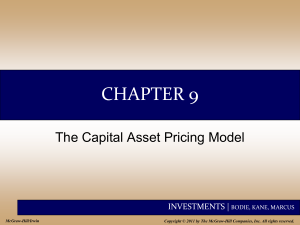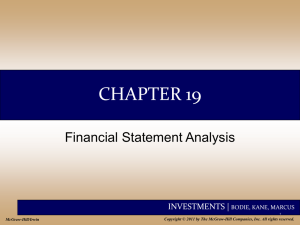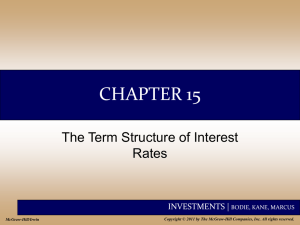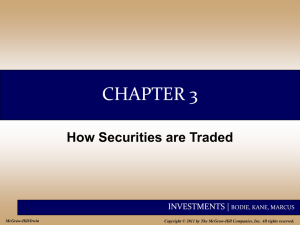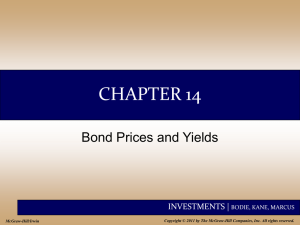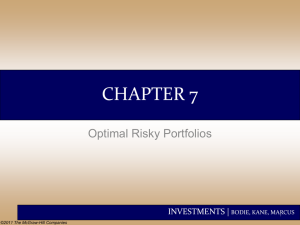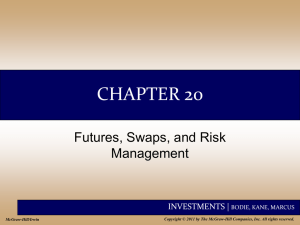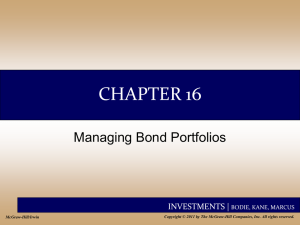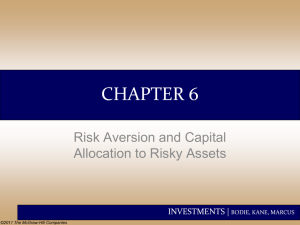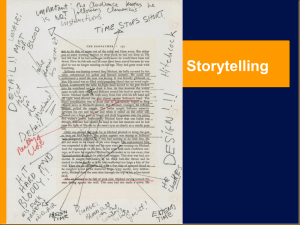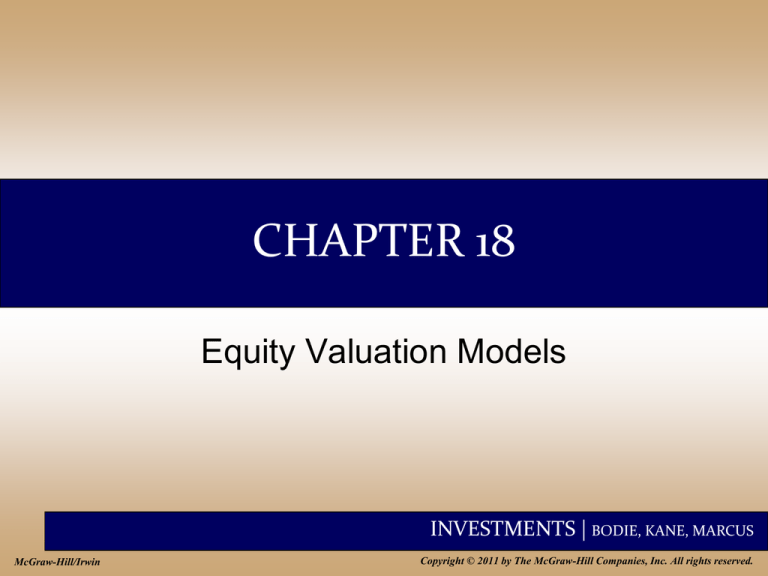
CHAPTER 18
Equity Valuation Models
INVESTMENTS | BODIE, KANE, MARCUS
McGraw-Hill/Irwin
Copyright © 2011 by The McGraw-Hill Companies, Inc. All rights reserved.
18-2
Valuation: Fundamental Analysis
• Fundamental analysis models a
company’s value by assessing its current
and future profitability.
• The purpose of fundamental analysis is to
identify mispriced stocks relative to some
measure of “true” value derived from
financial data.
INVESTMENTS | BODIE, KANE, MARCUS
18-3
Models of Equity Valuation
•
•
•
•
Balance Sheet Models
Dividend Discount Models (DDM)
Price/Earnings Ratios
Free Cash Flow Models
INVESTMENTS | BODIE, KANE, MARCUS
18-4
Valuation by Comparables
• Compare valuation ratios of firm to
industry averages.
• Ratios like price/sales are useful for
valuing start-ups that have yet to
generate positive earnings.
INVESTMENTS | BODIE, KANE, MARCUS
18-5
Limitations of Book Value
• Book values are based on historical cost,
not actual market values.
• It is possible, but uncommon, for market
value to be less than book value.
• “Floor” or minimum value is the liquidation
value per share.
• Tobin’s q is the ratio of market price to
replacement cost.
INVESTMENTS | BODIE, KANE, MARCUS
18-6
Intrinsic Value vs. Market Price
• The return on a stock is composed of
dividends and capital gains or losses.
Expected HPR= E (r )
E ( D1 ) E ( P1 ) P0
P0
• The expected HPR may be more or less
than the required rate of return, based on
the stock’s risk.
INVESTMENTS | BODIE, KANE, MARCUS
18-7
Required Return
• CAPM gives the required return, k:
k rf E (rM ) rf
• If the stock is priced correctly, k
should equal expected return.
• k is the market capitalization rate.
INVESTMENTS | BODIE, KANE, MARCUS
18-8
Intrinsic Value and Market Price
• The intrinsic value (IV) is the “true” value,
according to a model.
• The market value (MV) is the consensus
value of all market participants
Trading Signal:
IV > MV Buy
IV < MV Sell or Short Sell
IV = MV Hold or Fairly Priced
INVESTMENTS | BODIE, KANE, MARCUS
18-9
Dividend Discount Models (DDM)
D3
D1
D2
V0
...
2
3
1 k 1 k 1 k
• V0 =current value; Dt=dividend at
time t; k = required rate of return
• The DDM says the stock price
should equal the present value of all
expected future dividends into
perpetuity.
INVESTMENTS | BODIE, KANE, MARCUS
18-10
Constant Growth DDM
D0 1 g
D1
V0
kg
kg
g=dividend growth rate
INVESTMENTS | BODIE, KANE, MARCUS
18-11
Example 18.1 Preferred Stock and the
DDM
• No growth case
• Value a preferred stock paying a
fixed dividend of $2 per share when
the discount rate is 8%:
$2
Vo
$25
0.08 0
INVESTMENTS | BODIE, KANE, MARCUS
18-12
Example 18.2 Constant Growth DDM
• A stock just paid an annual dividend of
$3/share. The dividend is expected to
grow at 8% indefinitely, and the market
capitalization rate (from CAPM) is 14%.
D1
$3.24
V0
$54
k g .14 .08
INVESTMENTS | BODIE, KANE, MARCUS
18-13
DDM Implications
• The constant-growth rate DDM implies that a
stock’s value will be greater:
1. The larger its expected dividend per share.
2. The lower the market capitalization rate, k.
3. The higher the expected growth rate of
dividends.
• The stock price is expected to grow at the
same rate as dividends.
INVESTMENTS | BODIE, KANE, MARCUS
18-14
Estimating Dividend Growth Rates
g ROE x b
g = growth rate in dividends
ROE = Return on Equity for the firm
b = plowback or retention percentage rate
(1- dividend payout percentage rate)
INVESTMENTS | BODIE, KANE, MARCUS
18-15
Figure 18.1 Dividend Growth for Two
Earnings Reinvestment Policies
INVESTMENTS | BODIE, KANE, MARCUS
18-16
Present Value of Growth Opportunities
• The value of the firm equals the value
of the assets already in place, the nogrowth value of the firm,
• Plus the NPV of its future investments,
• Which is called the present value of
growth opportunities or PVGO.
INVESTMENTS | BODIE, KANE, MARCUS
18-17
Present Value of Growth Opportunities
• Price = No-growth value per share +
PVGO
E1
P0
PVGO
k
INVESTMENTS | BODIE, KANE, MARCUS
18-18
Example 18.4 Growth Opportunities
• Firm reinvests 60% of its earnings in
projects with ROE of 10%,
capitalization rate is 15%. Expected
year-end dividend is $2/share, paid out
of earnings of $5/share.
• g=ROE x b = 10% x .6 = 6%
$2
P0
$22.22
.15 .06
INVESTMENTS | BODIE, KANE, MARCUS
18-19
Example 18.4 Growth Opportunities
$2
P0
$22.22
.15 .06
• PVGO =Price per share – no-growth value per
share
$5
PVGO $22.22
$11.11
.15
INVESTMENTS | BODIE, KANE, MARCUS
18-20
Life Cycles and Multistage Growth Models
• Expected dividends for Honda:
2010 $.50 2012 $ .83
2011 $.66 2013 $1.00
• Since the dividend payout ratio is
30% and ROE is 11%, the “steadystate” growth rate is 7.7%.
INVESTMENTS | BODIE, KANE, MARCUS
18-21
Honda Example
• Honda’s beta is 0.95 and the risk-free rate
is 3.5%. If the market risk premium is 8%,
then k is:
• k=3.5% + 0.95(8%) = 11.1%
• Therefore:
D
D 1 g
$11.077
P 2014 2013
$31.68
2013
kg
kg
0.111 0.077
INVESTMENTS | BODIE, KANE, MARCUS
18-22
Honda Example
• Finally,
V2009
$0.50 $0.66 $0.83 $1 $31.68
2
3
1.111 1.111 1.111
1.1114
• In 2009, one share of Honda Motor
Company Stock was worth $23.04.
INVESTMENTS | BODIE, KANE, MARCUS
18-23
Price-Earnings Ratio and Growth
• The ratio of PVGO to E / k is the ratio of
firm value due to growth opportunities to
value due to assets already in place (i.e.,
the no-growth value of the firm, E / k ).
P0 1 PVGO
1
E
E1 k
k
INVESTMENTS | BODIE, KANE, MARCUS
18-24
Price-Earnings Ratio and Growth
• When PVGO=0, P0=E1 / k. The stock is
valued like a nongrowing perpetuity.
• P/E rises dramatically with PVGO.
• High P/E indicates that the firm has ample
growth opportunities.
INVESTMENTS | BODIE, KANE, MARCUS
18-25
Price-Earnings Ratio and Growth
• P/E increases:
– As ROE increases
– As plowback increases, as long as ROE>k
P0
1 b
E1 k ROE x b
INVESTMENTS | BODIE, KANE, MARCUS
18-26
Table 18.3 Effect of ROE and Plowback on
Growth and the P/E Ratio
INVESTMENTS | BODIE, KANE, MARCUS
18-27
P/E and Growth Rate
• Wall Street rule of thumb: The growth rate
is roughly equal to the P/E ratio.
• “If the P/E ratio of Coca Cola is 15, you’d expect
the company to be growing at about 15% per
year, etc. But if the P/E ratio is less than the
growth rate, you may have found yourself a
bargain.”
Quote from Peter Lynch in One Up on Wall Street.
INVESTMENTS | BODIE, KANE, MARCUS
18-28
P/E Ratios and Stock Risk
• When risk is higher, k is higher;
therefore, P/E is lower.
P 1 b
E kg
INVESTMENTS | BODIE, KANE, MARCUS
18-29
Pitfalls in P/E Analysis
• Use of accounting earnings
– Earnings Management
– Choices on GAAP
• Inflation
• Reported earnings fluctuate around the
business cycle
INVESTMENTS | BODIE, KANE, MARCUS
18-30
Figure 18.3 P/E Ratios of the S&P 500 Index
and Inflation
INVESTMENTS | BODIE, KANE, MARCUS
18-31
Figure 18.4 Earnings Growth for Two
Companies
INVESTMENTS | BODIE, KANE, MARCUS
18-32
Figure 18.6 P/E Ratios for Different
Industries, 2007
INVESTMENTS | BODIE, KANE, MARCUS
18-33
Other Comparative Value Approaches
• Price-to-book ratio
• Price-to-cash-flow ratio
• Price-to-sales ratio
INVESTMENTS | BODIE, KANE, MARCUS
18-34
Figure 18.7 Market Valuation Statistics
INVESTMENTS | BODIE, KANE, MARCUS
18-35
Free Cash Flow Approach
• Value the firm by discounting free cash
flow at WACC.
• Free cash flow to the firm, FCFF,
equals:
After tax EBIT
Plus depreciation
Minus capital expenditures
Minus increase in net working capital
INVESTMENTS | BODIE, KANE, MARCUS
18-36
Comparing the Valuation Models
• In practice
– Values from these models may differ
– Analysts are always forced to make
simplifying assumptions
INVESTMENTS | BODIE, KANE, MARCUS
18-37
The Aggregate Stock Market
• Explaining Past Behavior
• Forecasting the Stock Market
INVESTMENTS | BODIE, KANE, MARCUS
18-38
Table 18.4 S&P 500 Price Forecasts Under
Various Scenarios
INVESTMENTS | BODIE, KANE, MARCUS


